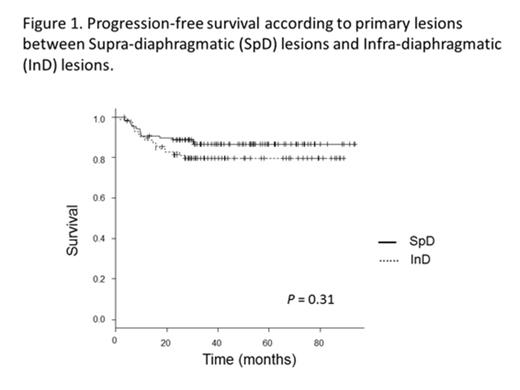Abstract
Background: Some studies evaluating differences in clinical features and outcome between supra-diaphragmatic (SpD) and infra-diaphragmatic (InD) primary lesions in Hodgkin lymphoma (HL) have been reported (Cancer 1991;68:1476-1481: Haematologica 2006;91:32-39). In regard to non-Hodgkin's lymphoma, there exist some previous studies that report on outcomes of patients with gastrointestinal (GI) involvement (J Clin Oncol 2005;23:2797-2804; Cancer 2003;97:2462-73). However, no studies comparing outcome between SpD and InD primary lesions have been conducted for patients with diffuse large B cell lymphoma (DLBCL). Thus, we retrospectively evaluated outcome differences between SpD and InD lesions, and the prognostic impact of GI involvement in limited-stage DLBCL.
Patients and Methods: We analyzed data from 178 patients with limited-stage DLBCL who were treated with rituximab plus cyclophosphamide (CPA), doxorubicin (DXR), vincristine (VCR), and prednisone (PSL; R-CHOP) therapy at 7 institutions of the Yokohama City University Hematology Group between 2003 and 2009. Patients who needed a dose reduction of more than 20% per cycle of R-CHOP therapy were excluded from the study. We classified the patients into SpD lesions group or InD lesions group according to the location of lesions. The patients in the InD lesions group were subsequently classified into InD with GI involvement group or InD without GI involvement group according to the presence of GI lesions. The impact of primary site location on patient outcome was evaluated using univariate and multivariate analyses.
Results: The study cohort included 104 men and 74 women with a median age of 63 years (range, 18-80 years). All patients were categorized as Ann Arbor stage I (n = 66) or II (n = 112). The primary sites were SpD in 109 patients and InD in 69 patients. There were no significant differences in distribution between the SpD lesions group and the InD lesions group with respect to age, sex, Ann Arbor stage, the IPI score, ECOG performance status, and the presence of a bulky mass. Significantly more patients in the InD group presented with B symptoms (P = 0.003). Comparing patients in the InD lesions group presenting with (n = 35) or without (n = 34) GI involvement, resulted in similar findings with respect to clinical characteristics. The group with GI involvement consisted of 20 patients with stomach lesions (57%), 7 with small intestine lesions (20%), 7 with colon lesions (20%), and 1 with both colon and rectum lesions (3%). The median observation period for all surviving patients was 52 months (range, 3 – 94 months). The 4-year progression-free survival (PFS) and overall survival (OS) rates of all 178 patients were 84% and 91%, respectively. Twenty-six patients presented with disease progression after R-CHOP therapy. In total, 16 patients died: 14 of recurrent lymphoma, 1 of secondary malignancy (acute lymphoblastic leukemia), and 1 as a result of an accident.
No statistical differences in PFS or OS were observed between patients with SpD lesions and those with InD lesions (4-year PFS rate: 87% and 81%, respectively; P = 0.31; Fig 1; 4-year OS rates: 92% and 86%, respectively; P = 0.31). When patients were classified and assessed according to primary site location, and their GI involvement status, which were SpD group, InD with GI involvement group, or InD without GI involvement group, the PFS rate was higher in SpD group (4-year PFS rates 86%), and InD with GI involvement group (4-year PFS rates 97%) than InD without GI involvement group (4-year PFS rates 67%; P = 0.036, and P = 0.003, respectively; Fig 2). However, no significant differences in regard to OS were observed among 3 groups (4-year OS rates: 93%, 97%, and 78%, respectively; P = 0.09).
The multivariate analysis revealed that SpD or InD localization had no independent effect on PFS or OS. In addition, primary sites according to the presence of GI lesions were incorporated into the multivariate analysis, whereas SpD, and InD were excluded as overlapping variable. The multivariate analysis revealed that the presence of GI involvement in patients with InD lesions was an independent prognostic factor in predicting favorable PFS (P = 0.024, HR 0.09).
Conclusion: No outcome differences were observed between SpD and InD lesions in limited-stage DLBCL. However, the presence of GI lesions was associated with a favorable prognosis.
No relevant conflicts of interest to declare.
Author notes
Asterisk with author names denotes non-ASH members.


This feature is available to Subscribers Only
Sign In or Create an Account Close Modal